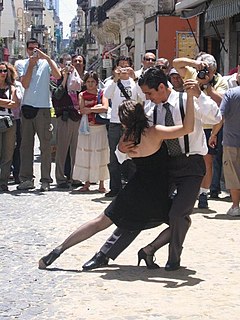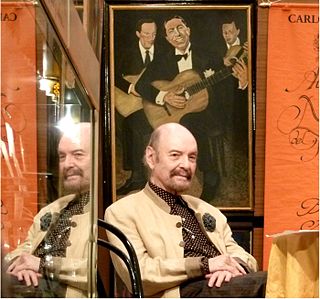
Carlos Gardel was a French Argentine singer, songwriter, composer and actor, and the most prominent figure in the history of tango. Gardel's baritone voice and the dramatic phrasing of his lyrics made miniature masterpieces of his hundreds of three-minute tango recordings. Together with lyricist and long-time collaborator Alfredo Le Pera, Gardel wrote several classic tangos.
Eladia Blázquez was an Argentine tango singer and composer. El corazón al sur is considered her most popular tango.

Libertad Lamarque ; was an Argentine actress and singer, one of the icons of the Golden Age of Argentine and Mexican cinema. She achieved fame throughout Latin America, and became known as “La Novia de América”. By the time she died in 2000, she had appeared in 65 films and six soap operas, had recorded over 800 songs and had made innumerable theatrical appearances.
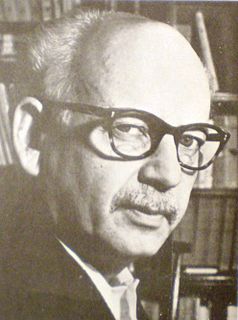
Bernardo Verbitsky was an Argentine writer and journalist.

The Café Tortoni is a coffeehouse located at 825 Avenida de Mayo in Buenos Aires, Argentina. Inaugurated in 1858 by a French immigrant whose surname was Touan, it was named Tortoni after the Parisian café of the same name located on Boulevard des Italiens. The café itself was Inspired by Fin de siècle coffee houses. Café Tortoni was selected by UCityGuides as one of the ten most beautiful cafes in the world.

Buenos Aires is in the midst of a tourism boom, according to the World Travel & Tourism Council, which reveals strong growth for Argentina Travel and Tourism in 2007 and in coming years, and the prestigious travel and tourism publication; Travel + Leisure, a monthly magazine, travelers voted Buenos Aires the second most desirable city to visit after Florence, Italy. Buenos Aires, regarded as the “Paris of South America”, offers elegant architecture, exquisite cuisine, a legendary nightlife, and fashionable shopping. Argentina has become famous for its rich European flavor.

Tita Merello was a prominent Argentine film actress, tango dancer and singer of the Golden Age of Argentine Cinema (1940–1960). In her 6 decades in Argentine entertainment, at the time of her death, she had filmed over thirty movies, premiered twenty plays, had nine television appearances, completed three radio series and had had countless appearances in print media. She was one of the singers who emerged in the 1920s along with Azucena Maizani, Libertad Lamarque, Ada Falcón, and Rosita Quiroga, who created the female voices of tango. She was primarily remembered for the songs "Se dice de mí" and "La milonga y yo".

The Confitería del Molino is an Art Nouveau style coffeehouse located on the corner of Callao and Rivadavia Avenues, in front of the Argentine National Congress in Buenos Aires, Argentina.

Norberto Esbrez was an Argentine tango dancer, choreographer and teacher.

María Rostworowski Tovar de Diez Canseco was a Peruvian historian known for her extensive and detailed publications about Peruvian Ancient Cultures and the Inca Empire.

Juan de Dios Filiberto was an Argentine violinist, conductor, poet and composer who became prominent in the Argentine tango genre.

The National Academy of History of the Argentine Republic is a non-profit learned society established to foster the study and dissemination of Argentine history.
Ángel Sebastián Arce is an Argentine tango dance and teacher.
Julio Mario Luqui-Lagleyze is an Argentine historian. Born in Buenos Aires in 1959 received a degree in History in 1982. He specializes in Hispano-American Military and Naval History and Military Museology. He is currently studying for his PhD in History at the Universidad Católica Argentina.
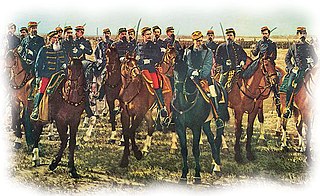
Saturnino Canaveri (1855–1939) was an Argentine military man, who served as officer of the 2nd Cavalry Regiment, participating in the actions against the Indians during the Conquest of the Desert.
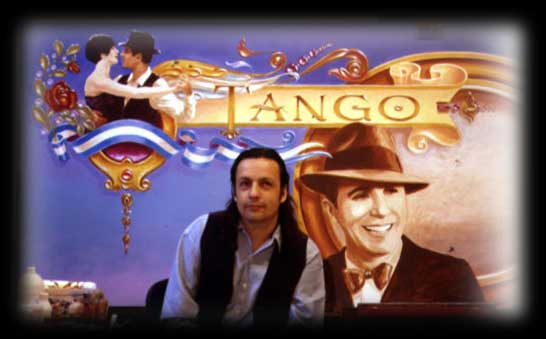
Jorge Muscia is a plastic artist and ‘fileteado’ instructor with over 30 years of experience in his field. Muscia, also known as the Fileteador of Tango, distinguishes himself for being a force in the revival of this old style of painting and for being a renowned instructor and promoter of the art of the filete in Argentina and the world.
Víctor Alberto Ramos is an Argentine geologist who has contributed to the paleogeography and plate tectonics of South America. He has been a member of the Chilean Academy of Science since 2001 and won in 2013 the Premio México de Ciencia y Tecnología.

Eloisa D'Herbil was a Spanish pianist and composer. A child prodigy on the piano, by age seven, she had played before the heads of state in England and Spain. As a child, the press dubbed her "Chopin in skirts" and from a young age, she began composing musical pieces. Immigrating to Argentina in 1868, she continued to write music, becoming one of the first women to write tangos.
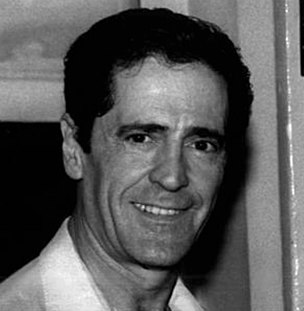
Nelson Avila is an Argentine born dancer, choreographer, and instructor. He is widely recognized for his expertise and knowledge of all types of Argentine dance, including Argentine folk dances and Argentine tango. He was part of the original cast of Tango Argentino, and together with his partner Nélida, was one of only three couples to perform solo in the original production. Tango Argentino is viewed by many as the catalyst that began the 1985 revival of Argentine tango in Europe, North America and then spread throughout the world. As an original member of the cast, Nelson Avila was an integral part of that Tango Argentino revival. He has always been noted for his quick feet and athletic ability on the dance stage. Nelson is a member of Academia Nacional del Tango de la República Argentina and is recognized as an authority of tango dance, history, music, musicians and its many styles and interpretations.
Carlos Canaveris known as "el pardo" was an Argentine musician. He integrated several Tango musical ensembles, including the trio formed with Ernesto Ponzio and José Fuster.




